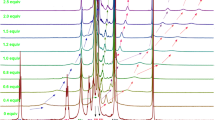Abstract
A bromide salt of 2,2′-(hexane-1,6-diyl) diisoquinolinium (K6) was designed, synthesized and introduced to construct a novel framework induced by π···π stacking of 2,2′-(alkylene-1,ω-diyl)diisoquinolinium from Q[6]-based pseudo-rotaxanes. The crystal structure of the compound revealed that the assembled framework based on the Q[6]-2,2′-(alkylene-1,6-diyl)diisoquinolinium pseudo-rotaxanes have stoichiometries of {(K6)@(Q[6])}2+·2Br−·7(H2O). The compound 1 has a novel three-dimensional framework constructed of two different channels―one containing stacked isoquinolyl moieties from the K6@Q[6] pseudorotaxanes and the other containing the bromide anions. 1H NMR spectra analysis was performed and confirmed the pseudorotaxane interaction model in which the 2,2′-(alkylene-1,6-diyl)diisoquinolinium guest threads into the cavity of Q[6] with the alkyl chain included inside the cavity and the two end isoquinolyl moieties protruding from the two opening portals. Absorption spectrophotometric and fluorescence spectroscopic analyses of the host–guest inclusion complex in aqueous solution found that the complexes were most stable at a host:guest mole ratio of 1:1. At this ratio, the complex has binding constants (K) ~106.






Similar content being viewed by others
References
Whang, D., Jeon, Y.-M., Heo, J., Kim, K.: Self-Assembly of a polyrotaxane containing a cyclic “bead” in every structural unit in the solid state: cucurbituril molecules threaded on a one-dimensional coordination polymer. J. Am. Chem. Soc. 118, 11333–11334 (1996)
Whang, D., Kim, K.: Polycatenated two-dimensional polyrotaxane net. J. Am. Chem. Soc. 119, 451–452 (1997)
Whang, D., Park, K.-M., Heo, J., Ashton, P., Kim, K.: Molecular necklace: quantitative self-assembly of a cyclic oligorotaxane from nine molecules. J. Am. Chem. Soc. 120, 4899–4900 (1998)
Roh, S.-G., Park, K.-M., Park, G.-J., Sakamoto, S., Yamaguchi, K., Kim, K.: Synthesis of a five-membered molecular necklace: a 2+2 approach. Angew. Chem. Int. Ed. 38, 638–641 (1999)
Lee, E., Heo, J., Kim, K.: Selective binding and highly sensitive fluorescent sensor of palmatine and dehydrocorydaline alkaloids by cucurbit[7]uril. Angew. Chem. Int. Ed. 39, 2699–2701 (2000)
Lee, E., Kim, J., Heo, J., Whang, D., Kim, K.: A two-dimensional polyrotaxane with large cavities and channels: a novel approach to metal-organic open-frameworks by using supramolecular building blocks. Angew. Chem. Int. Ed. 40, 399–402 (2001)
Ni, X.-L., Lin, J.-X., Zheng, Y.-Y., Wu, W.-S., Zhang, Y.-Q., Xue, S.-F., Zhu, Q.-J., Tao, Z., Day, A.I.: Supramolecular bracelets and interlocking rings elaborated through the interrelationship of neighboring chemical environments of alkyl-substitution on cucurbit[5]uril. Cryst. Growth Des. 8, 3446–3450 (2008)
Zeng, J.-P., Zhang, S.-M., Zhang, Y.-Q., Tao, Z., Zhu, Q.-J., Xue, S.-F., Wei, G.: Use of silver(I) and copper(II) ions to assist the self-assembly of polyrotaxanes incorporating symmetrical α,α’, δ,δ’-tetramethyl-cucurbit[6]uril. Cryst. Growth Des. 10, 4509–4515 (2010)
Lim, S., Kim, H., Selvapalam, N., Kim, K.J., Cho, S.J., Seo, G., Kim, K.: Cucurbit[6]uril: organic molecular porous material with permanent porosity, exceptional stability, and acetylene sorption properties. Angew. Chem. Int. Ed. 47, 3352–3355 (2008)
Kim, H., Kim, Y., Yoon, M., Lim, S., Park, S.M., Seo, G., Kim, K.J.: Highly selective carbon dioxide sorption in an organic molecular porous material. J. Am. Chem. Soc. 132, 12200–12202 (2010)
Park, K.M., Kim, S.Y., Heo, J., Whang, D., Sakamoto, S., Yamaguchi, K., Kim, K.: Q6-designed self-assembly of molecular necklaces. J. Am. Chem. Soc. 124, 2140–2147 (2002)
Ko, Y.H., Kim, K., Kang, J.K., Chun, H., Lee, J.W., Sakamoto, S.K., Yamaguchi, J.C., Kim, K.: Designed self-Assembly of molecular necklaces using host-stabilized charge-transfer interactions. J. Am. Chem. Soc. 126, 1932–1933 (2004)
Day, A., Arnold, A.P., Blanch, R.J., Snushall, B.: Controlling factors in the synthesis of cucurbituril and its homologues. J. Org. Chem. 66, 8094–8100 (2001)
Daniel, A.F., Donal, H.M., Lauren, J.W., John, P.W.: Kinetics and mechanism of ligand substitution reactions of pentacyanoferrate(II) complexes with bridging N-heterocyclic dications in aqueous media. Inorg. Chem. 32, 3425–3432 (1993)
Acknowledgments
This work was supported by the National Natural Science Foundation of China (NSFC; No. 20961002), the “Chun-Hui” Fund of the Chinese Ministry of Education, the Science and Technology Fund of Guizhou Province and the International Collaborative Project Fund of Guizhou province. All are gratefully acknowledged.
Author information
Authors and Affiliations
Corresponding authors
Rights and permissions
About this article
Cite this article
Fan, ZF., Xiao, X., Zhang, YQ. et al. A three dimensional framework induced by π···π stacking of 2,2′-(Alkylene-1,6-diyl)diisoquinolinium from Q[6]-based Pseudorotaxane. J Incl Phenom Macrocycl Chem 71, 577–581 (2011). https://doi.org/10.1007/s10847-011-9981-y
Received:
Accepted:
Published:
Issue Date:
DOI: https://doi.org/10.1007/s10847-011-9981-y




